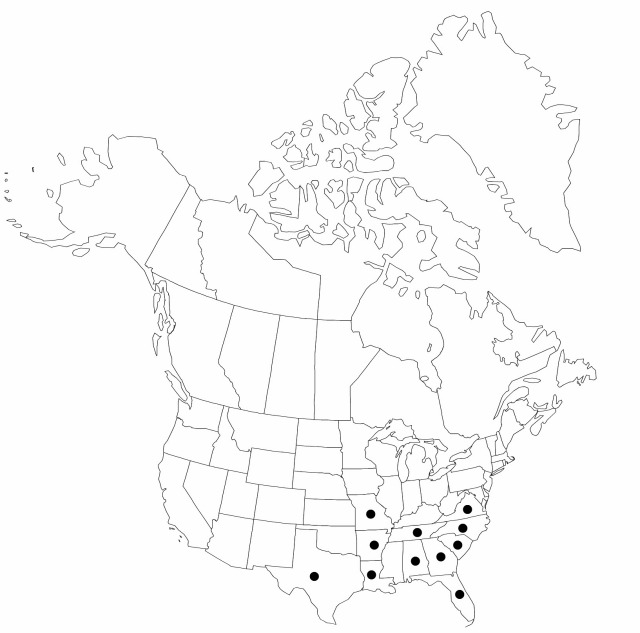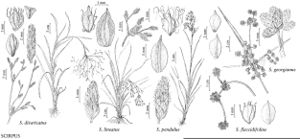Scirpus divaricatus
Sketch Bot. S. Carolina 1: 88, plate 2, fig. 4. 1816.
Plants cespitose; rhizomes not apparent. Culms: fertile ones lax, reclining, inflorescences lopping over to (or nearly to) ground; nodes frequently with axillary bulblets. Leaves 10–18 per culm; proximal leaf-sheaths green or brownish; proximal sheaths and blades with septa few, inconspicuous; blades 16–55 cm × 4–8 mm. Inflorescences terminal; rays divergent, proximal rays smooth, pedicels and distal rays scabrous, rays often bearing axillary bulblets; bases of involucral-bracts green or brownish, not glutinous. Spikelets in open cymes, central spikelet of each cyme sessile, others long-pedicellate, spikelets cylindric to narrowly ovoid, 4–14 × 1–2 mm; scales light-brown to reddish with broad green midribs, broadly ovate or elliptic, 1.2–1.8 mm, apex rounded to obtuse, apiculate, or sometimes short-mucronate, apiculus or mucro (if present) to 0.1 mm. Flowers: perianth bristles persistent, 6, stout, contorted, equaling or longer than achene, not projecting beyond it, with delicate, round-tipped, retrorse teeth in distal 1/2, enclosed within scales; styles 3-fid. Achenes off-white to yellowish-brown, elliptic-obovate in outline, strongly trigonous with very strong angles and concave sides, 0.8–1 × 0.6–0.8 mm. 2n = 28.
Phenology: Fruiting late spring–early summer (May–Jun).
Habitat: Lowland swamps along streams (often associated with Taxodium)
Elevation: 0–100 m
Distribution

Ala., Ark., Fla., Ga., La., Mo., N.C., S.C., Tenn., Tex., Va.
Discussion
The inflorescence of Scirpus divaricatus is very large and open. As in related species, the central spikelet of each cyme is sessile, and the others are long-pedicellate. The cymes often consist of only two spikelets in which the sessile, terminal spikelet may appear lateral.
Selected References
None.
Lower Taxa
"shortened" is not a number.
